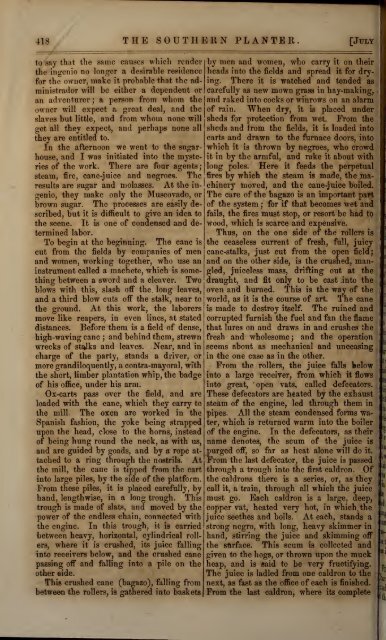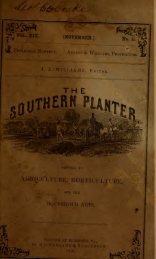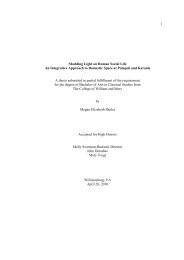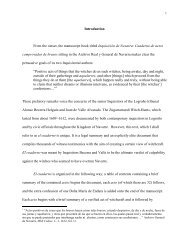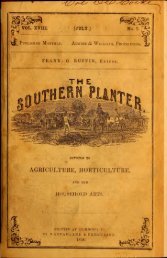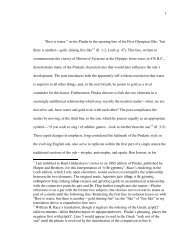Southern planter - The W&M Digital Archive
Southern planter - The W&M Digital Archive
Southern planter - The W&M Digital Archive
You also want an ePaper? Increase the reach of your titles
YUMPU automatically turns print PDFs into web optimized ePapers that Google loves.
418 THE SOUTHERN PLANTER [July<br />
to say that the same causes which render<br />
the ingenio no longer a desirable residence<br />
for the owner, make it probable that the administrador<br />
will be either a dependent or<br />
an adventurer ; a person from whom the<br />
owner will expect a great deal, and the<br />
slaves but little, and from whom none will<br />
get all they expect, and perhaps none all<br />
they are entitled to.<br />
In the afternoon we went to the sugarhouse,<br />
and I was initiated into the mysteries<br />
of the work. <strong>The</strong>re are four agents<br />
steam, fire, cane-juice and negroes. <strong>The</strong><br />
results are sugar and molasses. At the in-<br />
genio, they make only the Muscovado, or<br />
brown sugar. <strong>The</strong> processes are easily de-<br />
scribed, but it is difficult to give an idea to<br />
the scene. It is one of condensed and determined<br />
labor.<br />
To begin at the beginning. <strong>The</strong> cane is<br />
cut from the fields by companies of men<br />
and women, working together, who use an<br />
instrument called a machete, which is something<br />
between a sword and a cleaver. Two<br />
blows with this, slash off the. long leaves,<br />
and a third blow cuts off the stalk, near to<br />
the ground. At this woTk, the laborers<br />
move like reapers, in even lines, at stated<br />
into large piles, by the side of the platform.<br />
From these piles, it is placed carefully, by<br />
hand, lengthwise, in a long trough. This<br />
trough is made of slats, and moved by the<br />
power of the endless chain, connected with<br />
the engine. In this trough, it is carried<br />
•between heavy, horizontal, cylindrical roll-<br />
ers, where it is crushed, its juice falling<br />
into receivers below, and the crushed cane<br />
passing off and falling into a pile on the<br />
other side.<br />
This crushed cane (bagazo), falling from<br />
between the rollers, is gathered into baskets<br />
by men and women, who carry it on their<br />
heads into the fields and spread it for dry-<br />
ing. <strong>The</strong>re it is watched and tended as<br />
carefully as new mown grass in hay-making,<br />
and raked into cocks or winrows on an alarm<br />
of rain. When dry, it is placed under<br />
sheds for protection from wet. From the<br />
sheds and from the fields, it is loaded into<br />
carts and drawn to the furnace doors, into<br />
which it is thrown by negroes, who crowd<br />
it in by the armful, and rake it about with<br />
long poles. Here it feeds the perpetual<br />
fires by which the steam is made, the machinery<br />
moved, and the cane-juice boiled.<br />
<strong>The</strong> care of the bagazo is an important part<br />
of the system ; for if that becomes wet and<br />
fails, the fires must stop, or resort be had to<br />
wood, which is scarce and expensive.<br />
Thus, on the one side of the rollers is<br />
the ceaseless current of fresh, full, juicy<br />
cane-stalks, just cut from the open field;<br />
and on the other side, is the crushed, mangled,<br />
juiceless mass, drifting out at the<br />
draught, and fit only to be cast into the<br />
oven and burned. This is the way of the<br />
world, as it is the course of art. <strong>The</strong> cane<br />
is made to destroy itself. <strong>The</strong> ruined and<br />
corrupted furnish the fuel and fan the flame<br />
distances. Before them is a field of dense, that lures on and draws in and crushes the<br />
high-waving cane ; and behind them, strewn fresh and wholesome; and the operation<br />
wrecks of stajks and leaves. Near, and in seems about as mechanical and unceasing<br />
charge of the party, stands a driver, or in the one case as in the other.<br />
more grandiloquently, a contra-mayoral, wfth From the rollers, the juice falls below<br />
the short, limber plantation whip, the badge into a large receiver, from which it flows<br />
of his office, under his arm.<br />
into great, open vats, called defecators.<br />
Ox-carts pass over the field, and are <strong>The</strong>se defecators are heated by the exhaust<br />
loaded with the cane, which they carry to steam of the engine, led through them in<br />
the mill. <strong>The</strong> oxen are worked in the pipes. All the steam condensed forms wa-<br />
Spanish fashion, the yoke being strapped ter, which is returned warm into the boiler<br />
upon the head, close to the horns, instead of the engine. In the defecators, as their<br />
of being hung round the neck, as with us, name denotes, the scum of the juice is<br />
and are guided by goads, and by a rope at- purged off, so far as heat alone will do it.<br />
tached to a ring through the nostrils. At From the last defecator, the juice is passed<br />
the mill, the cane is tipped from the cart through a trough into the first caldron. Of<br />
the caldrons there is a series, or, as they<br />
call it, a train, through all which the juice<br />
must go. Each caldron is a large, deep,<br />
copper vat, heated very hot, in which, the<br />
juice seethes and boils. At each, stands a<br />
strong negro, with long, heavy skimmer in<br />
hand, stirring the juice and skimming off<br />
the surface. This scum is collected and<br />
given to the hogs, or thrown upon the muck<br />
heap, and is said to be very fructifying.<br />
<strong>The</strong> juice is ladled from one caldron to the<br />
next, as fast as the office of each is finished.<br />
From the last caldron, where its complete


